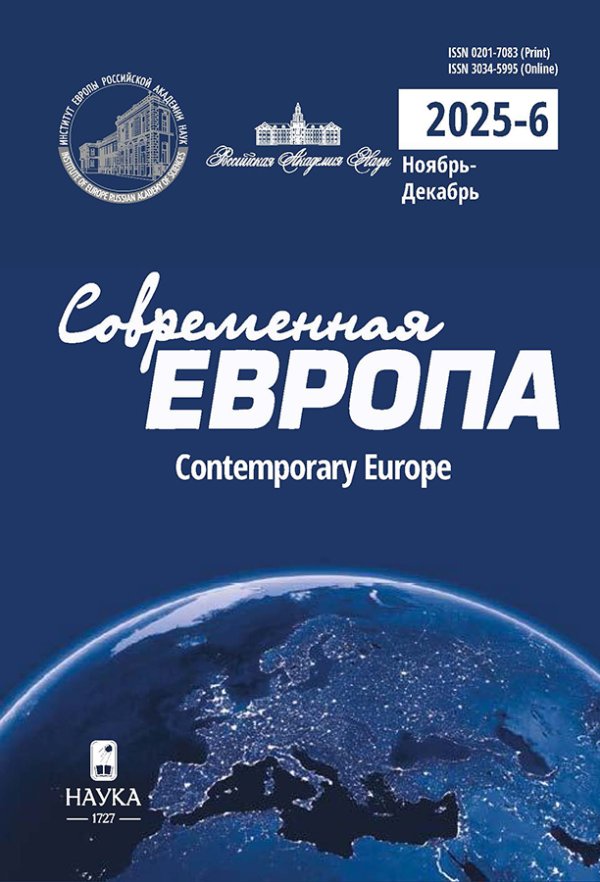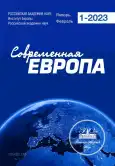Innovations in the EU communication policy
- Authors: Kondratieva N.B.1
-
Affiliations:
- Institute of Europe Russian Academy of Sciences
- Issue: No 1 (115) (2023)
- Pages: 21-33
- Section: Articles
- URL: https://journals.rcsi.science/0201-7083/article/view/144683
- DOI: https://doi.org/10.31857/S0201708323010023
- EDN: https://elibrary.ru/ORQJPO
- ID: 144683
Cite item
Full Text
Abstract
About the authors
Natalia Borisovna Kondratieva
Institute of Europe Russian Academy of Sciences
Email: nkondratieva@inbox.ru
Moscow, Russia
References
- Венидиктов С.В. (2018) Медиакоммуникация в развитии евразийского пространства: стратегический ресурс интеграции. БГУ, Минск, Белоруссия. 263 с.
- Винокуров Е.Ю. (2016) Евразийский экономический союз без эмоций. Вопросы экономики. № 12. С. 43-60.DOI: https://doi.org/10.32609/0042-8736-2016-12-43-60
- Корниенко Т. (2009) Сущность и структура политического мифа. Власть. № 10. С. 49-53.
- Кудж С.А., Цветков В.Я. (2019) Тринитарные системы. Российский технологический журнал. № 7(6). С. 151-167. doi: 10.32362/2500-316X-2019-7-6-151-167
- Потемкина О.Ю. (2022) Конференция о будущем Европы: итоги и перспективы. Научно-аналитический вестник ИЕ РАН. №3. С. 7-13. doi: 10.15211/vestnikieran32022713
- Сорель Ж. (2013) Размышления о насилии. Фаланстер, Москва. 293 с.
- Стрельник О.Н. (2012) Политический миф: рациональная видимость и иррациональная суть. Вестник Российского университета дружбы народов. Серия: Философия. № 2. С. 39-47.
- Флад К. (2004) Политический миф: теоретическое исследование. Прогресс-Традиция, Москва. 265 с.
- Потемкина О.Ю. (ред.) (2007)Формирование имиджевой политики Европейского Союза. Доклады Института Европы № 191. Институт Европы РАН, Москва. 107 с.
- Энтина Е.Г., Энтин М.Л. (2022) Конференция о будущем Европы как новейшая форма социальной поддержки интеграции. СовременнаяЕвропа. № 1. C. 21-34. doi: 10.31857/S0201708322010028
- Castells M. (2013)Communication Power. OUP Oxford, Oxford,UK. 590 p.
- Fontaine P. (2018)Europe in 12 lessons. European Commission, Directorate-General for Communication, Publications Office, Brussels, Belgium. 112 p. doi: 10.2775/206900
- Kazai V.Z., Bard P. (2021) Communication Strategy of the EU for Best Practice and Policy Recommendations. European Commission. 111 p.doi: 10.2139/ssrn.4093033
- Kritzinger S., Partheymüller J., Plescia C., Schüberl T., Wilhelm J. (2021) Discussions About the European Union Among Its Citizens. RECONNECT Deliverable 9.1. 35 p. URL: https://reconnect-europe.eu/wp-content/uploads/2021/01/D9.1.pdf (датаобращения: 10.11.2022)
- MüllerM., Braun C., Fraussen B. (2022) Cautious communicators: Strategic communication of European Union commissioners in regulatory decision-making. European Union Politics.No. 23(3).Р. 509-528. DOI: https://doi.org/10.1177/14651165221090743
- Pashentsev E. (ed.) (2022)Strategic Communication in EU-Russia Relations. Tensions, Challenges and Opportunities. Palgrave Macmillan Ltd, UK. 375 p. doi: 10.1007/978-3-030-27253-1
- Sala V.D. (ed.) (2010) Special Issue:Political Myth, Mythology and the European Union. Journal of Common Market Studies. No.48(1). 190 p.
- Soldevila Brea M.I. (2019) The European Commission's Strategic Shifts in Communication in Times of Contestation. The Case of the #EU and ME Campaign. Final dissertation. Université libre de Bruxelles, Brussels, Belgium. 47 p. URL: https://www.iee-ulb.eu/content/uploads/2019/10/SOLDEVILA-Maria-Isabel-MEUS-thesis-2019-final-version-with-annexes.pdf (дата обращения: 10.11.2022)
- Soproni L., Horga I. (2016) The EU's Voice Beyond its Borders: The European Union's External Communication. CES Working Papers.No. 8(3).P. 490-504.
- Vikhrova O., Hradzhiushka A., Muravyova O., Alekyan M., Akhmedova N. (2021) Information support of the Eurasian integration: The image of the EAEU in the mainstream media of the member states. World of Media. Journal of Russian Media and Journalism Studies. No. 2.P. 75-104. doi: 10.30547/worldofmedia.2.2021.4
Supplementary files










